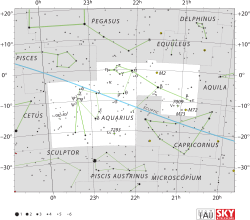101 Aquarii

| |
| Observation data Epoch J2000 Equinox J2000 | |
|---|---|
| Constellation | Aquarius |
| Right ascension | 23h 33m 16.62300s[1] |
| Declination | –20° 54′ 52.2155″[1] |
| Apparent magnitude (V) | 4.71[2] |
| Characteristics | |
| Spectral type | A0 V[3] |
| U−B color index | +0.00[2] |
| B−V color index | +0.02[2] |
| Astrometry | |
| Radial velocity (Rv) | +15[4] km/s |
| Proper motion (μ) | RA: –3.41[1] mas/yr Dec.: +8.46[1] mas/yr |
| Parallax (π) | 11.11 ± 0.67 mas |
| Distance | 290 ± 20 ly (90 ± 5 pc) |
| Details | |
| Rotational velocity (v sin i) | 180[5] km/s |
| Other designations | |
| Data sources: | |
| Hipparcos Catalogue, CCDM (2002), Bright Star Catalogue (5th rev. ed.) | |
101 Aquarii or b3 Aquarii (101 Aqr) is the Flamsteed designation for a binary star[7] in the equatorial constellation of Aquarius. The combined apparent visual magnitude of the pair is 4.71,[2] which is bright enough to be seen with the naked eye from the suburbs. The distance of this star from Earth is estimated as 290 light-years (89 parsecs) based upon parallax measurements.[1]
The brighter member of this system has an apparent magnitude of 4.81. It is an A-type main sequence star with a stellar classification of A0 V.[3] This star is spinning rapidly with a projected rotational velocity of 1 km/s.[5] The fainter companion is a magnitude 7.43 star at an angular separation of 0.840 arcseconds.[7]
References
- ↑ 1.0 1.1 1.2 1.3 1.4 van Leeuwen, F. (November 2007), "Validation of the new Hipparcos reduction", Astronomy and Astrophysics 474 (2): 653–664, arXiv:0708.1752, Bibcode:2007A&A...474..653V, doi:10.1051/0004-6361:20078357.
- ↑ 2.0 2.1 2.2 2.3 Nicolet, B. (1978), "Photoelectric photometric Catalogue of homogeneous measurements in the UBV System", Astronomy and Astrophysics Supplement Series 34: 1–49, Bibcode:1978A&AS...34....1N.
- ↑ 3.0 3.1 Houk, Nancy (1978), Michigan catalogue of two-dimensional spectral types for the HD stars 4, Ann Arbor: Dept. of Astronomy, University of Michigan, Bibcode:1988mcts.book.....H.
- ↑ Wilson, Ralph Elmer (1953), General Catalogue of Stellar Radial Velocities, Washington: Carnegie Institution of Washington, Bibcode:1953QB901.W495......
- ↑ 5.0 5.1 Royer, F.; Zorec, J.; Gómez, A. E. (February 2007), "Rotational velocities of A-type stars. III. Velocity distributions", Astronomy and Astrophysics 463 (2): 671–682, arXiv:astro-ph/0610785, Bibcode:2007A&A...463..671R, doi:10.1051/0004-6361:20065224.
- ↑ "101 Aqr -- Star", SIMBAD Astronomical Object Database (Centre de Données astronomiques de Strasbourg), retrieved 2012-07-03.
- ↑ 7.0 7.1 Eggleton, P. P.; Tokovinin, A. A. (September 2008). "A catalogue of multiplicity among bright stellar systems". Monthly Notices of the Royal Astronomical Society 389 (2): 869–879. arXiv:0806.2878. Bibcode:2008MNRAS.389..869E. doi:10.1111/j.1365-2966.2008.13596.x.
External links
| ||||||||||||||||||||||||||||||||||||||||||||||||||||||||||||||